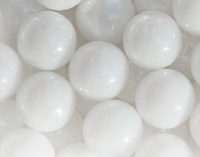Milling-Media Review: Part 3 - Bead Milling Operating Parameters



Machine Design
There are many types of agitator mills available on the market. Their designs and sophistication vary significantly. Fundamentally however, they all operate on the same basic principle. A liquid (product) is pumped through an agitated, fluidized bed of beads. Four main basic types can be identified.For the first three, the distinctions can certainly be less well defined than the simplified perspective given. The machines also can have different orientation; they can be aligned vertically or horizontally, for example. Each type of configuration has particular benefits in specific applications. No single machine design is perfect for every single process demand. Two important considerations that have a major effect on final designs are cooling and bead separation.

Cooling
As work is carried out inside the mill, there is an accompanying increase in product temperature. This can have a detrimental effect on the product and needs to be controlled. This control is achieved by the inclusion of a cooling jacket. The heat exchanged (Q) can be expressed as: Q = (K/X)*A*ΔT, where K is the thermal conductivity of material; X is thickness; A is the contact area; and ΔT is temperature difference. The contact area is therefore an important consideration in mill design (Figure 1).

Bead Separation

Machine Power and Size
Mills are designed to process required volumes of product, to a specified quality, during a particular time scale. This defines the ‘production capacity’ of the mill and is related to power and size of the machine. The machine must provide sufficient energy to achieve the desired grinding effect. It must also have sufficient capacity to accommodate the required flow rates of the product. The maximum production capacity (M) can be estimated on the basis of the specific energy requirement (EM) for the application and the converted diving power P- PO.M (t/h) = P - PO (KW)
EM (KWh/t)
where M = mass flow rate; P = power consumption; PO = idle power; EM = specific energy.
For example, if in a mill a power of P – PO = 250 KW is converted and the specific energy requirement is EM = 50 KWh/t, the net production capacity is M(t/h) = 5 t/h (dry material).
From the above equation, it follows that maximum production capacity is reached if (1) the power input to the grinding chamber is maximized and (2) the specific energy requirements of the product are minimized.
Developments in agitator mills have tended to maximize the intensity of the milling action, high power in limited volume, with maximized flow rates. The graph in Figure 3 highlights the evolution in mill power and flow rate, per unit volume of mill, for various machine designs.

Tip Speed

Conclusion
As with many aspects of operating bead mills, there is a compromise limiting mill speed to provide adequate productivity without incurring excessive cost due to increased wear. To accommodate mill wear issues, various materials are incorporated as discs and linings: steel, plastics, ceramics, etc. Each of these has merit in particular applications and has consequences for correct media choice.For more information, contact zirpro@saint-gobain.com or www.zirpro.com or email author at paul.hassall@saint-gobain.com.
Looking for a reprint of this article?
From high-res PDFs to custom plaques, order your copy today!





